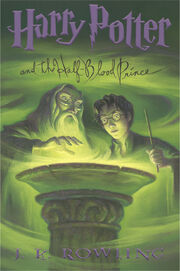
Scholastic's logo as it appears on the Harry Potter books
Scholastic is an American publishing house that publishes the Harry Potter books and its complementary novels in the United States. It is the only company to have published J. K. Rowling's novels in English besides Bloomsbury, the original publisher in the United Kingdom.
On 31 July, 2012 (Harry Potter's birthday), Scholastic launched a Harry Potter Reading Club.[1]
On 2013, Kazu Kibuishi (an American author and illustrator) was asked to design and create special edition cover art for the fifteenth anniversary of the Harry Potter series. These special editions were available in advance online (the final book released on Harry Potter's birthday). The books were offcially released on 27 August, 2013.
Singularity of Scholastic Harry Potter books[]

The Scholastic edition of Harry Potter and the Half-Blood Prince
The main difference between Scholastic and Bloomsbury editions of the books is the covers and the spelling (Scholastic uses American spelling for words such as symbolise, which is spelt as symbolize). Also, the title of the first novel differs between the two publishers. Bloombsbury published the first novel as Harry Potter and the Philosopher's Stone, whereas in America the novel was published as Harry Potter and the Sorcerer's Stone. Early criticism was directed at Levine for changes that were made to the author’s English prose. There were around 80 word changes in Sorcerer's stone and some significant alteration in the placing of commas. When questioned, in March 2012, he responded that ‘I did not do anything to the text. Every change was something that I discussed with Jo. In fact, Jo came up with the alternative title of Sorcerer’s Stone… It’s one of the most common conversations that you have in a publishing company with a writer. The conversation goes something like this: “I presented this to the sales and marketing department and they feel that the title doesn’t do this… So let’s consider alternatives”. Of course if the author says “no absolutely not – that’s my title” then that’s the title that goes on the book. It’s a simple matter. But authors are professional people and sometimes just changing the title gives the sales and marketing department a degree of confidence that helps your book.’ Levine noted that he needed a title that said ‘magic’ more overtly to American readers. He continued, ‘I certainly did not mind Harry Potter and the Philosopher’s Stone but I can see, if you forget now what happened after, …why a book that is titled Philosopher’s Stone might seem more arcane or something. So the title that I had suggested to me and which I then turned to Jo was Harry Potter and the School of Magic. Jo very thoughtfully said “No – that doesn’t feel right to me... there are objects that I would like. What if we called it the Sorcerer’s Stone?” And that completely does it."[2]
Other, very minor, differences in wording occur throughout the Scholastic editions, preferring American nomenclature over British, such as the word "soccer" instead of "football" or "sweater" instead of "jumper." Also, the text is a bit bigger and, unlike Bloomsbury, at the beginning of every chapter there is a small picture illustrated by Mary GrandPré. In addition to standard typographical changes (including italics, capitals and small capitals) there are other typographical features exclusive to the American editions, such as facsimile of signatures, "handwritten" texts, quill writing, newspaper headlines, advertisement signs, etc.
Scholastic covers of the Harry Potter series also have a characteristic stylized logo of the franchise name, notable for the lightning-shaped P. It later became the logo of the film series.
